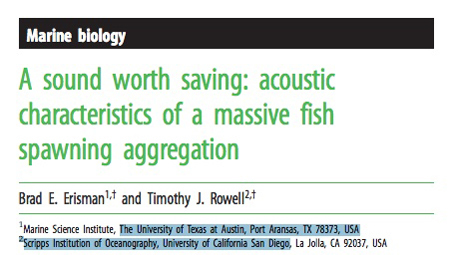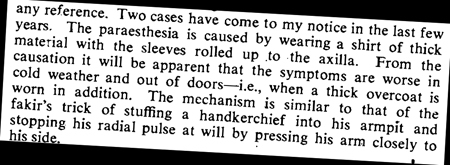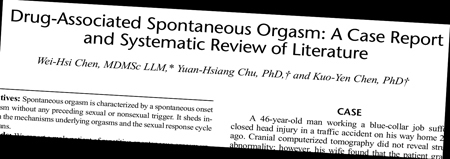Marc Abrahams's Blog, page 200
December 20, 2017
Hand cooling from illusion not linked to change in body ownership
An article in Acta Psychologica has a hot take on temperatures in hands that may, or may not, belong to you. The paper “No consistent cooling of the real hand in the rubber hand illusion” gives an example of the importance of distinguishing body ownership:
Consider a simple task such as walking towards another person –say, this huge big shot you noticed at a conference – and shaking hands… among this sea of moving limbs you will need to keep track of which ones are yours, so you can walk away again without making a complete fool out of yourself. To do so, your brain needs to know which parts of the world are “you” and which parts are not.
While it may seem clear to you that you own your own hand, psychologists can use the Rubber Hand Illusion (RHI) to convince the brain that a rubber hand is your own hand. During the RHI, touches on the owned rubber hand can cause participants to feel the touch.
But what happens to the previously owned real hand? Older experiments suggested that when you disown your hand, the temperature of that hand drops slightly. Since many hands makes light work, this newer research was determined to replicate the experiments with as many owned, and not owned, hands as possible.

The researchers convinced 167 participants that the participants owned rubber hands. After extensive temperature measurements, they found that:
…although the presence of temperature changes of the hands in RHI experiments might be determined by various factors, an overall analysis of RHI experiments in our lab in the last 5 years, covering five replications of the traditional RHI experiment and totaling 167 participants… suggests that hand temperature changes in the RHI are not causally related to changes in body ownership.

The incident of the Suspected-Soviet-Sub, the Swedish Navy, and the Farting Herring
“Fishes caused Sweden to be afraid of being attacked by Soviet submarines in 1982” is a report by VN Express (in Vietnamese) about the secret incident that years later produced the 2004 Ig Nobel Biology Prize.
The central figures in the story: farting herring. It is an open question, biologically speaking, whether the herring do or do not use their farts (produced by expelling air from the swim bladder) to communicate.

Ig Nobel Prize winner Magnus Wahlberg tells the story, now that the official veil of secrecy is lifted, in this TEDx talk video:
This week [late December, 2017] brings news reports about the equivalent sound, produced by a different species of fish—a fish called croaker. The scientific study about this identifies it with these words: “The Gulf corvina (Cynoscion othonopterus) is a species of croaker (family: Sciaenidae) endemic to the Northern Gulf of California, Mexico.”
The Washington Post headline about this new study: “Biologists record the machine-gun sound of the loudest known fish.” The study itself is called “A sound worth saving: acoustic characteristics of a massive fish spawning aggregation,” published in the journal Biology Letters. The scientists (at the The University of Texas at Austin and the University of California San Diego) doing this new research apparently choose not to use the plain-language description “farting fish.”

Magnus Wahlberg, the Ig-Nobel-winning co-author of the herring-fart-sound study that co-won that 2004 Ig Nobel biology prize, says (today) of these developments:
“It is very interesting to see how stories about fish sounds can keep rolling and rolling and rolling! There are more than 30,000 species of fish – and so far we have only listened to a handful of them. There is a lot more to find out. And some true enigmas: the goldfish has one of the most sensitive ears among all fish – but we never heard a goldfish ever say anything. So, what on earth are they listening for?”

December 19, 2017
Noseflutes for Christmas anyone?
Stuck for ideas for Christmas presents? Thought about noseflutes? Before purchasing (or making your own, as above), you can find all the information you require for an informed decision at Noseflute.org – since 2011, the definitive online resource for all things noseflute-related.
A review of the ‘Nasalette’ replica, as featured in the video above, can be found here.
BONUS: Antoine Carolus of Noseflute.org provides many more noseflute videos here.
Also see: Melanesian nose-flutes – did they ever exist?

December 18, 2017
Medical danger of wearing rolled-up shirtsleeves
A medical report about the danger of rolling up your sleeves is featured in the December 2012 issue of mini-AIR.
mini-AIR is an email newsletter— a tiny supplement to the un-tiny magazine Annals of Improbable Research.
You can subscribe to the newsletter (it’s email, that comes once a month) for free.
You can subscribe to the magazine (meaty, juicy PDFs—six new ones every year) for just a few bucks.
BONUS: Someone found it desirable to produce a four-minute-long video explanation of how to roll up your shirtsleeves. Here is that video:

Reindeer nasal glow: update

Many years, around Christmas, bright new explanations appear as to why reindeer noses might glow.”Glow” is a word from the song “Rudolph the Red Nosed Reindeer,” but the general discussion centers on the possible redness—be it glowing or be it subdued, be it observed or be it imagined—of a reindeer’s nose.
A new article in the Dutch biology research journal Deinsea furthers the quest. It takes flight from a study published in 2012 in the same journal. (We discussed that 2012 thesis here, under the headline “Physiology: Why Rudolph’s Nose is Red.”)
The new study is: “Rudolph the red nosed reindeer had a very bioluminescent nose. A reply to van der Hoven et al. 2012,” Neil Crooks, Claire E. Marriott, Hannah R. Clifforth, Zain A. Ahmed, Arnold Xhikola, Samuel G. Penny, and Angelo P. Pernetta, Deinsea, 17, 2017, pp. 39-42. The authors, at the University of Brighton, UK, explain:
“Research published in Deinsea by van der Hoven et al. (2012) identifies the cause of Rudolph’s infamous red nose to be the consequence of hyperemia of the nasal mucosa induced by the exertion of pulling a heavy load. Van der Hoven et al. (2012) claim that the excessive stresses endured whilst flying with Santa Claus and the sleigh in tow resulted in cerebral and bodily hyperthermia, overworking the nasal cooling system, causing the nose to glow. Whilst we recognise van der Hoven et al.’s (2012) central tenet of highly vascularized nasal mucosa in reindeer (Rangifer tarandus) helping regulate nasal heat exchange, we concluded that this is unlikely to be the causal factor of Rudolph’s particularly iridescent appendage for multiple reasons, detailed below.”
Here is a photoshopped image of a reindeer nose that is on display in the natural history museum in Rotterdam, The Netherlands. (The museum publishes the research journal Deinsea). Below the photo is a video of a person performing the song “Rudolph the Rednosed Reindeer.”
BONUS: Alternative Rudolph’s-red-nose theories appear, like the reindeer of childrens’ desire, whenever humanity needs or wants them. One alternative involves flies that get up a reindeer’s nose. The history of that idea is explored in an article in Wired magazine: “Reindeer Bot Flies Are Not Particularly Festive.”

Drug-Associated Spontaneous Orgasm (DASO): Problem, or Opportunity?
Pharmaceutical companies might experience spontaneous fiscal arousal upon reading a new medical study about drugs that may cause spontaneous orgasms. The study is:
“Drug-Associated Spontaneous Orgasm: A Case Report and Systematic Review of Literature,” Wei-Hsi Chen, Yuan-Hsiang Chu, and Kuo-Yen Chen, Clinical Neuropharmacology, epub 2017. The authors, at Shu-Te University and Chang Gung University, Taiwan, explain:
We report a male patient of repetitive spontaneous orgasm under trazodone treatment and systematically review the literature on drug-associated spontaneous orgasm (DASO)…. A total of 25 patients (18 women and 7 men), including our reported case, experienced 27 DASO events…. A reduction of dose or discontinuation of the offending drug usually abolished DASO….
Sex and age seem to have no influence on occurrence of DASO events….
Index drugs induced SPONO [spontaneous orgasm] but did not change the quality of the classical orgasm….
There is an equal likelihood that SPONO will occur within 7 days or between 8 days and 1 month after drug use regardless of drug type. An immediate reaction following drug administration is rare.
Smart investors can be on the listen for mention of the suddenly-chic phrases “DASO” and “SPONO”, at cocktail parties where pharma executives roam.
Marc Gozlan wrote an appreciation of this new research, in the Réalités Biomédicales blog in Le Monde: “Ces médicaments qui déclenchent des orgasmes spontanés.”

December 16, 2017
Wilhelm Conrad Röntgen joins the LFHCfS (Luxuriant Facial Hair Club for Scientists)
Wilhelm Conrad Röntgen (1845-1923) has joined the Historical Honorary Members of the Luxuriant Flowing Hair Club for Scientists.
Known as the “Father of Radiology”, he discovered and investigated X-Rays while experimenting with vacuum tubes in 1895. He named them "X-Rays" because they were an unknown form of radiation and he refused to patent his discovery. He received the very first Nobel Prize in Physics (1901). Other honors include a peak in Antarctica, a radioactive element (Rg), and a unit of measurement named in his honor.
Nov 8th, the anniversary of his discovery, is observed both as International Day of Radiology and also as World Radiography Day.
HAIR LEGACY
Images of Röntgen’s beard helped inspire Radiologist Philipp Weisser to grow his own beard, which in turn qualified him to join the hair club.
"…Last but not least, my beard is a homage to the Godfather of science in radiology, Wilhelm Conrad Röntgen." – P. Weisser, LFHCfS
Mr. Weisser mentioned this inspiration when he joined the LFHCfS, prompting the club to investigate and decide that, yes, Röntgren did indeed have impressive facial hair!

December 15, 2017
“Swearing helps us battle pain – no matter what language we curse in”
A replication (with Japanese-language speakers and English-language speakers) of the Ig Nobel Peace Prize-winning experiment (with only English-language speakers) about swearing and pain, described by one of the researchers, in The Conversation:
Swearing helps us battle pain – no matter what language we curse in
The new study is “Swearing as a response to pain: A cross-cultural comparison of British and Japanese participants,” Olivia Robertson [pictured here], Sarita Jane Robinson, and Richard Stephens, Scandinavian Journal of Pain, epub 2017.

December 14, 2017
Even more applications for graphene (continued)
The Nobel Prize in Physics 2010 was awarded jointly to Andre Geim (see note [1] below) and Konstantin Novoselov for their groundbreaking experiments regarding the extraordinary properties of two-dimensional carbon. Nowadays, the burgeoning cornucopia of applications is such that a 21st century individual can literally kit themselves from head to toe with accoutrements which feature graphene (or claim to – see notes [2] & [3] below). Here are but a few examples :
• Graphene reinforced spectacles
• Graphene based sensor gloves
• Graphene Far Infrared Biomass Socks [pictured]
• Graphene enhanced shoe soles
Notes :
[1] Professor Andre Geim was awarded the 2000 Ig Nobel Physics prize – along with Sir Michael Berry of Bristol University, UK – for using magnets to levitate a frog. [reference: “Of Flying Frogs and Levitrons” by M.V. Berry and A.K. Geim, European Journal of Physics, v. 18, 1997, p. 307-13.)
[2] According to the International Union of Pure and Applied Chemistry (IUPAC) “The term graphene should be used only when the reactions, structural relations or other properties of individual layers are discussed.” That’s to say, if it’s more than one atom thick, it’s not graphene, but a graphite layer, a carbon layer, or a carbon sheet instead.
[3] Not all claims for the applications of graphene are necessarily 100% accurate.
BONUS (form 2012): Graphene From Garbage (and Girl Scout cookies and bugs)

December 13, 2017
Sound Pressures Generated by Exploding Eggs
The claims made in lawsuits – and the need to verify or disprove them – sometimes spark interesting research. The Acoustical Society of America’s Fall 2017 meeting included a report titled, “Sound pressures generated by exploding eggs”.

Some eggs and some safety gear
(photo by D. Kessler)
Investigators Anthony Nash and Lauren von Blohn began this research thanks to a lawsuit: A restaurant had hard-boiled an egg and then re-heated it in a microwave before serving it. When the customer bit into the egg, it exploded with enough force and heat to cause burns and, importantly for this research, possible hearing loss.
The court could not find data on whether an exploding egg might cause hearing loss, so it contacted acoustical consulting firm, Charles M. Salter Associates, where Nash and von Blohn began their research:
“An acoustical investigation was conducted using nearly 100 eggs that were re-heated under controlled conditions in a calibrated microwave oven. About a third of the re-heated, boiled eggs exploded outside the oven. For those eggs that did explode, their peak sound pressure levels ranged from 86 up to 133 decibels at a distance of 300 millimeters. The paper will describe the test protocols and discuss the results.”

dB chart from dangerousdecibels.org (does not mention eggs)
Most claims of hearing damage come from noise experienced over a sustained period of time – longer than the milliseconds of an egg explosion – but in this case, the offending egg was considerably closer than 300 millimeters away when it exploded. Nash and von Blohn began a second round of research to study the possible effects of an “in-mouth explosion”.
The lawsuit was settled out of court, but the research it sparked remains for any future court cases.
(Thanks to D. Grodzins for bringing this article to our attention.)
HEARING BONUS: The Centers for Disease Control and Prevention (CDC) have articles on the sonic dangers of Vuvuzelas and also of being a NASCAR driver or pit crew member. The CDC has declared October to be National Protect Your Hearing Month.
EGG BONUS: Cooked egg-white is white because the heat has changed how its proteins are folded. The 2015 Ig Nobel Prize for Chemistry was awarded for inventing a chemical recipe to partially un-boil an egg.
COURTROOM BONUS: Another example of a lawsuit whose premise required original research received the 2009 Ig Nobel Prize for investigating whether it is better to be smashed over the head with a full bottle of beer or with an empty bottle.
A demonstration of the phenomenon

Marc Abrahams's Blog
- Marc Abrahams's profile
- 14 followers








